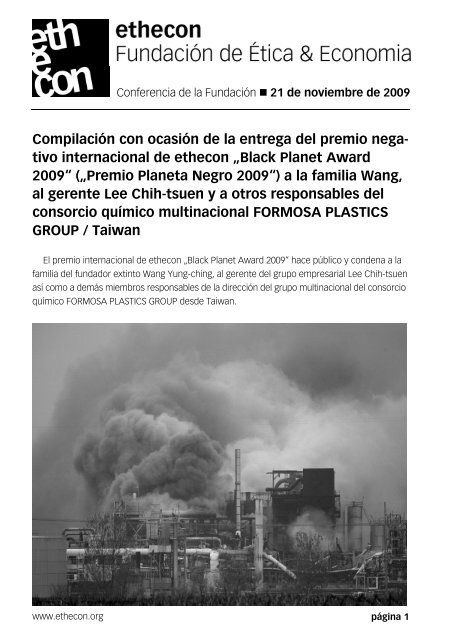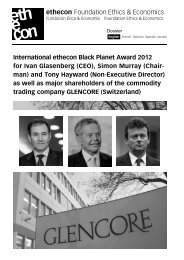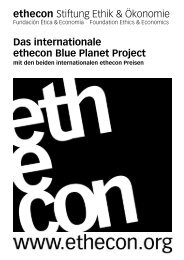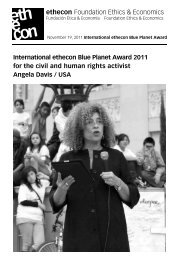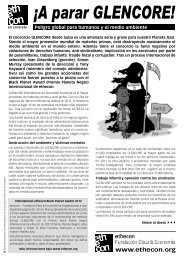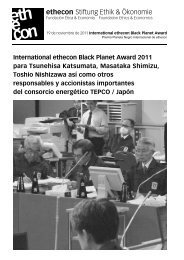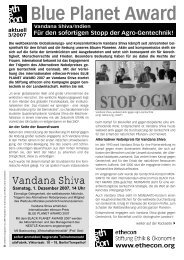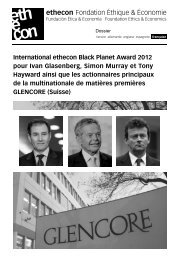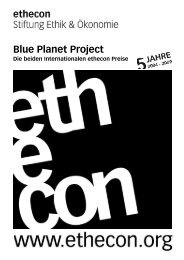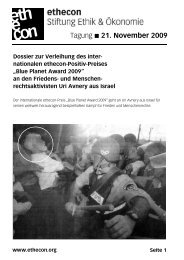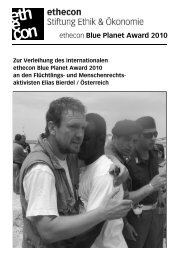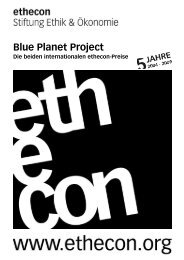Dossier Formosa Plastics / Black Planet 2009 - Ethecon
Dossier Formosa Plastics / Black Planet 2009 - Ethecon
Dossier Formosa Plastics / Black Planet 2009 - Ethecon
Create successful ePaper yourself
Turn your PDF publications into a flip-book with our unique Google optimized e-Paper software.
www.ethecon.org<br />
Conferencia de la Fundación 21 de noviembre de <strong>2009</strong><br />
Compilación con ocasión de la entrega del premio negativo<br />
internacional de ethecon „<strong>Black</strong> <strong>Planet</strong> Award<br />
<strong>2009</strong>“ („Premio <strong>Planet</strong>a Negro <strong>2009</strong>“) a la familia Wang,<br />
al gerente Lee Chih-tsuen y a otros responsables del<br />
consorcio químico multinacional FORMOSA PLASTICS<br />
GROUP / Taiwan<br />
El premio internacional de ethecon „<strong>Black</strong> <strong>Planet</strong> Award <strong>2009</strong>“ hace público y condena a la<br />
familia del fundador extinto Wang Yung-ching, al gerente del grupo empresarial Lee Chih-tsuen<br />
así como a demás miembros responsables de la dirección del grupo multinacional del consorcio<br />
químico FORMOSA PLASTICS GROUP desde Taiwan.<br />
página 1
Conferencia de la Fundación 21 de noviembre de <strong>2009</strong><br />
Compilación familia Wang, Lee Chih-tsuen<br />
y otros responsables FORMOSA<br />
Continuación<br />
Vida y obra de los responsables del FORMOSA PLASTICS GROUP<br />
El consorcio FORMOSA PLASTICS GROUP (FPG) tiene su origen en la época del anticomunismo<br />
y de la Guerra Fría. Fue fundado en 1954 en Taiwan, estado insular1 separado de la República<br />
Popular de China por el líder de mala fama Chiang Kai-shek violando el derecho internacional.<br />
Los nombres del FPG y de sus filiales2 provocan y desafían, de manera obvia, a la RP China,<br />
con la denominación „<strong>Formosa</strong>“ usada por las autoridades coloniales al referirse a la isla de<br />
Taiwán. Al el mismo tiempo contienen una indicación de que el fundador de la compañía,<br />
Wang Yung-ching, se benefició mucho con los acontecimientos y masacres del Kuomintang<br />
dirigidos por derechistas y anticomunistas, y que fueron tolerados o incluso apoyados por los<br />
EE.UU al final de la Segunda Guerra Mundial – lo que suele quedar sin ser mencionado. Por<br />
consecuencia, su empresa ha sido fundada con el dinero estadounidense. 3 Hasta su muerte en<br />
el año 2008 Wang era uno de los hombres más ricos de la Tierra con el capital de 6,8 mil<br />
millones de dólares.<br />
Hoy día el FORMOSA PLASTICS GROUP tiene un volumen de venta total de 66 mil millones<br />
de dólares americanos y 94 mil empleados (2008) y forma parte de los grupos empresariales<br />
más salientes a nivel mundial. En el reporte anual comercial del FPG son listadas varias<br />
1 En 1945, después de la derrota del Japón, Taiwan ha sido integrado, de acuerdo a las intenciones militares de los Aliados (Declaración de<br />
Cairo) en la República de China bajo el liderazgo de Chiang Kai-shek, mientras en la parte continental de China se reanudó la guerra civil entre<br />
las fuerzas gobernadoras de Kuomintang (KMT) y los comunistas chinos. Primero fueron las tropas de la República acogidas con mucho<br />
entusiasmo por los taiwaneses, pero pronto llegó a haber, a causa de la corrupción omnipresente, tremenda inflación y caída económica,<br />
tensiones entre la población y la administración impuesta por el gobierno de Kuomintang las que se desahogaron, luego de un incidente del 28<br />
de febrero de 1947, en una insurrección popular y opresión sangrienta de aquella. En 1949, el gobierno de Kuomintang (KMT) bajo Chiang Kaishek<br />
se fugó para la isla, después de la derrota en la guerra civil de China. Hoy día, sólo 23 Estados mantienen relaciones diplomáticas<br />
oficiales hacia Taiwan. (Fuente: Wikipedia http://de.wikipedia.org/wiki/Taiwan-Konflikt / http://de.wikipedia.org/wiki/Taiwan.)<br />
2 Entre otros pertenecen sociedades siguientes al <strong>Formosa</strong> <strong>Plastics</strong> Group (compare entre otros: www.fpg.com): Chang Gung Biotechnology<br />
Corp., <strong>Formosa</strong> Asahi Spandex Co. Ltd., <strong>Formosa</strong> Automobile Corp., <strong>Formosa</strong> Chemical & Fiber Corp.,<strong>Formosa</strong> Daikin Advanced Chemicals Co.<br />
Ltd., <strong>Formosa</strong> Heavy Industries Corp., <strong>Formosa</strong> Komatsu Silicon Corp., <strong>Formosa</strong> Petrochemical Corp., <strong>Formosa</strong> Plasma Display Corp., <strong>Formosa</strong><br />
<strong>Plastics</strong> Corp., <strong>Formosa</strong> <strong>Plastics</strong> Maritime Corp., <strong>Formosa</strong> Taffeta Corp., <strong>Formosa</strong> Technology Corp., <strong>Formosa</strong> Teletek Corp., <strong>Formosa</strong> Transport<br />
Corp., Hwa Ya Power Corp., Inotera Memories Inc., Mailiao Power Corp., MIZ Port Management Corp., Nan YA <strong>Plastics</strong> Corp., Nan Ya Printed<br />
Circuit Board Corp., Nan Ya Technology Corp., PFG Fiber Glass Corp., Tah Shi Spinning Corp., Weng Fun Industrial Co., VIA Technologies<br />
3 The New York Times del 17.10.2008 - http://www.nytimes.com/2008/10/17/business/17wang.html<br />
página 2 www.ethecon.org
Compilación familia Wang, Lee Chih-tsuen<br />
y otros responsables FORMOSA<br />
Continuación<br />
www.ethecon.org<br />
Conferencia de la Fundación 21 de noviembre de <strong>2009</strong><br />
docenas de empresas en Taiwán, China, Vietnam y en otros países incluyendo también<br />
empresas en los EE.UU. En Taiwán mismo pertenecen al consorcio tres de las diez empresas<br />
más importantes que cotizan en la bolsa. Sus ramos principales de la producción son química,<br />
bio-tecnología, electrónica, cosméticos, detergentes domésticos, repuestos para automóviles<br />
y medicamentos.<br />
Las experiencias demuestran que los informes oficiales del consorcio ofrecen sólo una<br />
impresión incompleta del tamaño real y verdadero de un consorcio multinacional. Esto se da<br />
porque no hay prácticamente ninguna posibilidad de observar y controlar las estructuras<br />
económicas multinacionales. Incluso las medidas nacionales de control fracasan frente al<br />
poder económico de las compañías trasnacionales. Habitualmente, detrás de las cifras<br />
oficiales de un consorcio siempre se esconde un „imperio de sombra“ de la misma dimensión<br />
al cual pertenecen, por ejemplo, empresas oficialmente independientes pero cuyos productos<br />
son comprados sólo por comprador, poniendo así su producción bajo el domino de este<br />
consorcio.<br />
Aunque muchos consorcios del FORMOSA PLASTICS GROUP cotizan en la bolsa, taiwanesa,<br />
no obstante, solamente se puede saber muy poco sobre aquellos. La discreción asiática se<br />
combina aquí con el interés de no dejar penetrar afuera más que el mínimo posible de información<br />
con respecto a manejos turbios. Sobre todo dado que el imperio había sido dirigido<br />
patriarcalmente por el fundador Wang Yung-ching hasta su muerte, y ahora queda en las<br />
manos de su familia y del gerente nombrado por él, Lee Chih-tsuen.<br />
La historia del consorcio está acompañada de una serie continua de crímenes sociales y<br />
ecológicos de dimensión global. Algunos ejemplos de esto son:<br />
> El escándalo relacionado al PVC que atraviesa la historia de la compañía desde su fundación:<br />
4 el PVC forma parte de la química de cloro sentenciada en el mundo entero a partir del<br />
4 En la producción del PVC son empleados ambos gases muy explosivos así como tóxicos: cloruro de vinilo y dicloruro de etileno. El cloruro de<br />
vinilo, descolorido y fácilmente inflamable, se convierte luego de la reacción con la luz, el aire y el calor en el PVC. Luego de quemar el cloruro<br />
página 3
Conferencia de la Fundación 21 de noviembre de <strong>2009</strong><br />
Compilación familia Wang, Lee Chih-tsuen<br />
y otros responsables FORMOSA<br />
Continuación<br />
inicio de los años 80 del siglo XX por los daños extremos que causa al ambiente y a la salud<br />
humana. Pero a pesar de esto, los peligros descubiertos provenientes del PVC para la ecología<br />
del planeta (cuya cifra sigue creciendo) nunca han sido para el FPG motivo para parar<br />
la producción. Todo lo contrario, de forma realmente cínica, el consorcio ha aprovechado la<br />
reducción, por razones ambientalistas, de producción y uso de los productos de PVC en el<br />
mundo, aumentado así sus ganancias. Ha llegado así a ser uno de los mayores productores<br />
mundiales del PVC. Incluso ha violado y sigue violando la prohibición de la producción del<br />
PVC declarada por el gobierno de Taiwán trasladando las plantas productivas a los países<br />
que no tienen esta prohibición.<br />
> Alrededor de las plantas de FORMOSA en el mundo entero, el consorcio deteriora el<br />
ambiente y amenaza la salud humana. Por ejemplo en Point Comfort en Texas son registrados<br />
niveles altos de concentración de EDC (dicloruro de etileno) en las aguas freáticas y en<br />
las cuencas. También el suelo y el agua corriente cerca de la empresa PGG Industries por la<br />
cual el FORMOSA en Texas deja eliminar una parte de sus residuos de EDC están contaminados.<br />
> La OSHA (Administración Americana para la seguridad y salud laboral) así como la CSB<br />
(Chemical Safety Board – Institución Federal para la Seguridad en la industria química) objetan<br />
regularmente el trato inadecuado de los materiales tóxicos el cual ya ha causado innu-<br />
de vinilo se forman ácido clorhídrico y huellas del gas neurotóxico „fosgeno“, usado en la Segunda Guerra Mundial como medio químico de<br />
lucha asií como de „dioxino“, el veneno químico de mala fama e indudablemente el más peligroso que exista. Las características tóxicas del<br />
cloruro de vinilo fueron por primera vez descubiertas en los años 60 – antes aquel era sólo calificado como aturdidor e irritador para los ojos.<br />
Pero a inicios de los años 70 fueron reconocidas sus propiedades tóxicas para el ser humano. El cuadro clínico de la enfermedad proveniente<br />
del cloruro de vinilo muestra que el hígado, el esófago y el bazo así como el riego sanguíneo de las manos, los huesos de la mano y la piel son<br />
afectados por aquella. Además, este material está calificado como cancerígeno. También el gas igualmente descolorido, inflamable y<br />
venenoso con olor a cloro, el dicloruro de etileno, constituye un peligro para la salud. El dicloruro de etileno irrita la piel, tiene un efecto<br />
narcótico, contribuye a mutaciones genéticas, al carcinoma y provoca daños de órganos internos (hígado, riñones, sangre). Igualmente hace<br />
subir el riesgo de partos prematuros y abortos espontáneos. Una vez tragado, envenena el organismo y es cancerígeno. Luego de quemarlo<br />
pueden formarse unos gases peligrosos y no controlables. La substancia perjudica el ambiente y contamina las aguas (nivel TRES de peligro<br />
para el agua según la clasificación vigente). El dicloruro de etileno se emplea para la producción del cloruro de vinilo. Además está empleado<br />
en los decapantes, gasolinas a plomo, disolventes para resinas y asfaltos.<br />
página 4 www.ethecon.org
Compilación familia Wang, Lee Chih-tsuen<br />
y otros responsables FORMOSA<br />
Continuación<br />
www.ethecon.org<br />
Conferencia de la Fundación 21 de noviembre de <strong>2009</strong><br />
merables contaminaciones del agua potable. Sólo en el año 1990 han sido oficialmente<br />
constatados 54 casos de contaminación del agua potable por el FORMOSA en los EE.UU. 5<br />
> El tratamiento incorrecto de materiales fácilmente inflamables también ha sido objetado<br />
regularmente por las oficinas de control. No se efectúan de forma debida ni el mantenimiento<br />
ni las reparaciones. 6<br />
> En los EE.UU., han sido oficialmente detectados numerosos casos de fuga de materiales<br />
tóxicos. Incluso en cantidades elevadas, como por ejemplo en los años 80, cuando en Texas<br />
63 toneladas de dicloruro de etileno se escaparon en medio de una zona residencial. 7<br />
> Se repiten casos de muerte y daños graves de salud. Por causa de fuga de dicloruro de<br />
etileno se asfixiaron en 1997 dos obreros en los EE.UU. También en 1998 hubo un accidente<br />
más con este material. En una explosión en 1998 en Texas hubo 26 empleados heridos. En<br />
la planta de Illinois en el año 2004 perecieron seis obreros luego de una explosión y muchas<br />
personas más fueron heridas. El otro caso de peligro, el más reciente hasta ahora, sucedió<br />
en octubre de 2005, cuando once empleados fueron gravemente heridos.<br />
> La población en los alrededores de las plantas del FORMOSA PLASTICS GROUP (FPG) vive<br />
bajo una permanente amenaza muy seria. Por causa de las explosiones, reventaron repetidas<br />
veces los vidrios en las casas situadas a varias leguas de distancia de las plantas. El<br />
suelo, el aire y el agua alrededor de las fábricas están contaminados. Luego de una explosión<br />
en la planta de Illinois, las comunidades contiguas tuvieron que ser completamente<br />
evacuadas.<br />
> En 1998, el FORMOSA PLASTICS GROUP ha intentado arrojar simplemente en el mar, ante el<br />
puerto camboyano de Sihanoukville, tres mil toneladas de residuos tóxicos. Hasta hoy la<br />
gente en Camboya sufre bajo la contaminación por los residuos del FPG.<br />
5 Fuentes: http://www.osha.gov/pls/osaweb/owares.do_search/ http://www.csb.gov/newsroom/detail.aspx?nid=173<br />
6 Ibídem.<br />
7 Ibídem.<br />
página 5
Conferencia de la Fundación 21 de noviembre de <strong>2009</strong><br />
Compilación familia Wang, Lee Chih-tsuen<br />
y otros responsables FORMOSA<br />
Continuación<br />
> En el año 2000, <strong>Formosa</strong> tuvo que pagar 150.000 dólares de multa al gobierno de Texas por<br />
rebasar los valores límites de la contaminación del aire. 8<br />
> En enero de <strong>2009</strong>, los científicos en Texas comprobaron una concentración elevada de<br />
materiales tóxicos (en el aire y en el suelo) cerca de las fábricas de <strong>Formosa</strong>. Los ganaderos<br />
observaron cambios en el ambiente y en la fauna causados por materiales que provocan el<br />
cancer y destruyen el ADN. Los toros bajaron de peso, algunas vacas parieron terneros con<br />
tres patas, con frecuencia hubo partos fallidos y abortos espontáneos. <strong>Formosa</strong> negó que<br />
sus fábricas tenían la culpa por aquello9. La Environmental Protection Agency (Oficina para<br />
la Protección del Ambiente) ha publicado un estudio sobre las intoxicaciones del ganado<br />
vacuno. Allí fueron identificados 43 venenos diferentes que son emitidos por las fábricas.<br />
Muchos de los que son conocidos como cancerígenos. 9<br />
> El 30 de septiembre de <strong>2009</strong>, <strong>Formosa</strong> ha sido condenado por la Environmental Protection<br />
Agency de los EE.UU. así como por el US Department of Justice a pagar 13 millones de<br />
dólares de multa por contaminaciones graves del suelo, del aire y del agua. El dinero deberá<br />
ser invertido en las medidas reductoras de la contaminación del aire.<br />
> Los obreros de FORMOSA PLASTICS en los EE.UU. se unieron en una organización bajo el<br />
nombre „Injured Workers United“ („Obreros afectados unidos“). Sobre la base de sus propias<br />
experiencias y de enfermedades graves causadas por su empleo en las fábricas de<br />
FORMOSA PLASTICS CROUP, los obreros tomaron la decisión de acusar al FPG públicamente<br />
en una carta abierta.<br />
> En Taiwan, la empresa está en la lista de los 10 contaminadores máximos del ambiente.<br />
25 porciento de todos los gases de efecto invernadero echados en Taiwan son causados<br />
por el FPG.<br />
8 www.environmentalhealthnews.org/ehs/toxic-home-on-the-range<br />
9 Ibídem.<br />
página 6 www.ethecon.org
Compilación familia Wang, Lee Chih-tsuen<br />
y otros responsables FORMOSA<br />
Continuación<br />
www.ethecon.org<br />
Conferencia de la Fundación 21 de noviembre de <strong>2009</strong><br />
La actitud de los responsables del FORMOSA PLASTICS GROUP en lo concerniente a las<br />
leyes y los derechos, la ecología y la paz, los derechos sociales y los derechos humanos en<br />
general así como en lo concerniente a las condiciones de seguridad y protección del ambiente<br />
dentro de la producción, quedan demostrados de manera singular con el siguiente ejemplo: ha<br />
sido imposible entregales personalmente los papeles con las reglas jurídicas en la fábrica en<br />
Delaware / EE.UU. Por eso tuvieron que ser echar los papeles desde un helicóptero. Eso<br />
cuadra con el hecho de que tampoco haya traído cambio alguno en su actitud, ni siquiera la<br />
lista enorme de multas contra el consorcio (elevándose algunas de ellas hacia un millón de<br />
dólares).<br />
Los responsables tampoco les hacen caso a las protestas masivas en distintos países. En<br />
Taiwan y en otros países siempre vuelve a haber manifestaciones multitudinarias contra el<br />
FORMOSA PLASTICS GROUP.<br />
La empresa es de una delincuencia ambiental tal que incluso la Asociación de empresarios<br />
de la industria química de los EE.UU., la American Chemical Society, se niega a cooperar con<br />
el FPG.<br />
La empresa tiene sus responsables. Son los propietarios y los directores. A ellos les toca la<br />
responsabilidad por la política del consorcio y, por consecuencia, por los crímenes sociales y<br />
ecológicos cometidos.<br />
Hoy día la empresa está dirigida por los miembros de la familia del fundador Wang Yungching<br />
y por el gerente nombrado aún por aquel personalmente, Lee Chih-tsuen. A la familia del<br />
extinto Wang Yung-ching pertenecen su esposa, sus dos hijos, siete hijas, sus cuatro hermanas y<br />
su hermano. La familia forma parte de los clanes más ricos del planeta. Su capital se supone<br />
de ascender a 70 mil millones de dólares. Ellos son responsables por la ruina de la salud<br />
humana y la destrucción del ambiente en dimensiones graves, incluso la muerte de muchas<br />
personas. Están actuando sólo a favor del enriquecimiento personal y aceptando el fin de<br />
nuestro planeta, alcanzando éste el estado de un „<strong>Planet</strong>a Negro“.<br />
página 7
Conferencia de la Fundación 21 de noviembre de <strong>2009</strong><br />
Compilación familia Wang, Lee Chih-tsuen<br />
y otros responsables FORMOSA<br />
Continuación<br />
Por esta violación extraordinaria de la ética y de la moral, „ethecon – Fundación Ética &<br />
Economía“ estigmatiza a los miembros de la familia Wang, al gerente de FORMOSA PLASTICS<br />
GROUP Lee Chih-tsuen y a los directores responsables del grupo empresarial con el „<strong>Black</strong><br />
<strong>Planet</strong> Award <strong>2009</strong>“. Ellos constituyen con su actuar no sólo un peligro para la paz y los<br />
derechos humanos sino que también para la democracia, la ecología y para la humanidad<br />
entera.<br />
La fundación va a entregar, junto con los activistas de los movimientos sociales del mundo<br />
entero, el premio negativo internacional de ethecon „<strong>Black</strong> <strong>Planet</strong> Award <strong>2009</strong>“ a los responsables<br />
mencionados del FORMOSA PLASTICS GROUP frente a la oficina central del consorcio<br />
en Taipeh / Taiwan.<br />
página 8 www.ethecon.org
Compilación familia Wang, Lee Chih-tsuen<br />
y otros responsables FORMOSA<br />
Continuación<br />
FORMOSA PLASTICS GROUP<br />
201 Tung Hwa North Road<br />
Taipei, Taiwan, R. O. C.<br />
Tel : 886-2-27122211<br />
Fax: 886-2-27129211<br />
http://www.fpg.com.tw<br />
E-mail: 00ra07@fpg.com.tw<br />
www.ethecon.org<br />
Conferencia de la Fundación 21 de noviembre de <strong>2009</strong><br />
página 9
Conferencia de la Fundación 21 de noviembre de <strong>2009</strong><br />
Compilación familia Wang, Lee Chih-tsuen<br />
y otros responsables FORMOSA<br />
Continuación<br />
Selección de organizaciones no gubernamentales que se ocupan del tema FPG:<br />
> Basel Action Network<br />
122 S. Jackson Street, Suite 320<br />
Seattle, WA 98104<br />
USA / EE. UU.<br />
Teléfono: 1-206-652-5555<br />
Fax: 1-206-652-5750<br />
eMail: inform@ban.org<br />
Internet: www.ban.org<br />
> Center for Health, Environment and Justice<br />
P.O. Box 6806<br />
Falls Church, VA 22040-6806<br />
USA / EE.UU.<br />
Teléfono: 212 - 964 - 3680<br />
eMail: mike@chej.org<br />
Internet www.chej.org / www.besafenet.com/pvc<br />
> Environmental Health Sciences<br />
421 Park St., Ste. 4<br />
Charlottesville, Virginia 22902<br />
USA / EE.UU.<br />
Teléfono: 434-220-0348<br />
Fax: 434-220-0347<br />
eMail: feedback@environmentalhealthnews.org<br />
Internet: www.environmentalhealthnews.org<br />
página 10 www.ethecon.org
Compilación familia Wang, Lee Chih-tsuen<br />
y otros responsables FORMOSA<br />
Continuación<br />
> Wild at Heart / Taiwan<br />
Teléfono: 886-2-2382-5789<br />
Fax: 886-2-2382-5810<br />
eMail: robin@wildatheart.org.tw<br />
Internet: www.wildatheart.org.tw<br />
www.ethecon.org<br />
Conferencia de la Fundación 21 de noviembre de <strong>2009</strong><br />
página 11
Conferencia de la Fundación 21 de noviembre de <strong>2009</strong><br />
Compilación familia Wang, Lee Chih-tsuen<br />
y otros responsables FORMOSA<br />
Continuación<br />
Selección de enlaces:<br />
http://www.coking.com/forum/tm.asp?m=450<br />
http://en.wikipedia.org/wiki/<strong>Formosa</strong>_<strong>Plastics</strong>_Group<br />
http://en.wikipedia.org/wiki/<strong>Formosa</strong>_<strong>Plastics</strong><br />
http://www.fpg.com.tw/index_eng.asp<br />
http://www.fpcusa.com/<br />
http://www.nytimes.com/2008/10/17/business/17wang.html?_r=1&scp=1&sq=formosa%20pla<br />
stic%20group&st=cse<br />
http://www.usatoday.com/news/nation/2005-10-07-texasexplosion_x.htm<br />
http://www.commondreams.org/headlines05/1007-09.htm<br />
http://www.taipeitimes.com/News/biz/archives/<strong>2009</strong>/06/06/2003445503<br />
http://www.chinapost.com.tw/taiwan/t-business/<strong>2009</strong>/05/29/210051/p2/<strong>Formosa</strong>-<strong>Plastics</strong>.htm<br />
http://www.taiwantoday.tw/ct.asp?xItem=59695&CtNode=436<br />
http://www.osha.gov/pls/osaweb/owares.do_search<br />
http://www.csb.gov/newsroom/detail.aspx?nid=173<br />
http://www.environmentalhealthnews.org/ehs/news/toxic-home-on-the-range<br />
página 12 www.ethecon.org
Compilación familia Wang, Lee Chih-tsuen<br />
y otros responsables FORMOSA<br />
Continuación<br />
Greetings Wild at Heart / Taiwan<br />
www.ethecon.org<br />
Conferencia de la Fundación 21 de noviembre de <strong>2009</strong><br />
Wild at Heart Legal Defense Association, Taiwan is grateful to <strong>Ethecon</strong> for pillorying of the<br />
<strong>Formosa</strong> <strong>Plastics</strong> Corporation with this year’s <strong>Black</strong> <strong>Planet</strong> Award. A member of the <strong>Formosa</strong><br />
<strong>Plastics</strong> Group, responsible for nearly 30% of Taiwan’s total carbon emissions, <strong>Formosa</strong><br />
<strong>Plastics</strong> has managed to fool governments and large parts of the population around the world<br />
into allowing it to operate in a manner that poisons people and the rest of the environment<br />
wherever <strong>Formosa</strong> <strong>Plastics</strong> and its affiliates go.<br />
Perhaps the <strong>Black</strong> <strong>Planet</strong> Award to <strong>Formosa</strong> <strong>Plastics</strong> will help bring attention to Taiwan’s<br />
shame, to the company that more than any other represents the sacrifice of fishers, farmers<br />
livelihoods through its destruction and pollution of sea coasts and farmland. Perhaps this will<br />
expose how its promises of jobs and prosperity to one of the poorest areas in Taiwan have<br />
amounted to nil, or rather have resulted in the area becoming a forgotten wasteland where<br />
people are forced to breathe toxins and where the gangsters and politicians elected with<br />
support from <strong>Formosa</strong> <strong>Plastics</strong> are indistinguishable. High government officials admit that “all<br />
the gangsters in Yunlin (location of <strong>Formosa</strong> <strong>Plastics</strong>’ largest facility in Taiwan) are raised and<br />
nutured by <strong>Formosa</strong>”.<br />
Wild at Heart’s director Robin Winkler was a commissioner with Taiwan EPA’s Environmental<br />
Impact Assessment Commission for two years during which he joined other commissioners in<br />
attempting to hold <strong>Formosa</strong> <strong>Plastics</strong> to its promises, commitments and legal obligations. During<br />
this time the degree of <strong>Formosa</strong> <strong>Plastics</strong>’ influence on government, academia and enforcement<br />
officials was startlingly clear. The commission was unable to obtain complete, accurate or<br />
timely information on <strong>Formosa</strong> <strong>Plastics</strong>’ activities. After Robin left the commission he was beat<br />
up in the Taiwan EPA by a locally elected gangster while the manager of <strong>Formosa</strong> <strong>Plastics</strong><br />
looked on.<br />
página 13
Conferencia de la Fundación 21 de noviembre de <strong>2009</strong><br />
Compilación familia Wang, Lee Chih-tsuen<br />
y otros responsables FORMOSA<br />
Continuación<br />
In the summer of <strong>2009</strong> a health study was made public concerning the populations in areas<br />
adjacent to <strong>Formosa</strong> <strong>Plastics</strong>’ largest project in Taiwan the 6th Naphtha Plant but the Taiwan<br />
EPA has just sat on the report.<br />
We hope this award will raise international awareness about this global gangster and pressure<br />
will be put on the Taiwan government to bring them to account.<br />
Wild at Heart / Taiwan<br />
Telefon 886-2-2382-5789<br />
Fax 886-2-2382-5810<br />
eMail robin@wildatheart.org.tw<br />
Internet www.wildatheart.org.tw<br />
página 14 www.ethecon.org
Compilación familia Wang, Lee Chih-tsuen<br />
y otros responsables FORMOSA<br />
Continuación<br />
Open Letter PVC Campaign / USA<br />
www.ethecon.org<br />
Conferencia de la Fundación 21 de noviembre de <strong>2009</strong><br />
Greetings and solidarity from the United States.<br />
The Center for Health, Environment and Justice (CHEJ) would like to thank ethecon for awarding<br />
<strong>Formosa</strong> <strong>Plastics</strong> GROUP, its CEO Lee Chih-tsuen, as well as to its founder and capital<br />
provider, the Wang Family, this year’s <strong>2009</strong> <strong>Black</strong> <strong>Planet</strong> award.<br />
<strong>Formosa</strong> <strong>Plastics</strong> is one of the largest manufacturers of PVC plastic in the world, and PVC is<br />
without a doubt the most toxic plastic for our health and environment. No other plastic<br />
contains or releases as many dangerous chemicals. These include dioxins, phthalates, vinyl<br />
chloride, ethylene dichloride, lead, cadmium, and even bisphenol A. There’s no safe way to<br />
manufacture, use or dispose of PVC products throughout its lifecycle.<br />
PVC plants are disproportionately located in low-income communities and communities of<br />
color, making the production of PVC an issue of environmental justice and racism for neighboring<br />
residents. PVC manufacturing facilities have poisoned workers and fenceline neighbors,<br />
polluted the air, contaminated drinking water supplies, and even wiped entire communities off<br />
the map.<br />
Each year, in the U.S. PVC plants pump some 500,000 pounds of vinyl chloride – a known<br />
human carcinogen - and many other toxins into the atmosphere. Cancer-causing Dioxins are<br />
released into the atmosphere from the production and eventual disposal of PVC. When its<br />
entire lifecycle is considered, PVC appears to be associated with the release of more Dioxins<br />
than any other single product.<br />
According to the International Agency for Research on Cancer and the U.S. National Toxicology<br />
Program, vinyl chloride is a known human carcinogen, and ethylene dichloride is a<br />
probable human carcinogen. Workers in plants that manufacture PVC or its feedstocks receive<br />
the highest exposures to these compounds in workplace air—81,000 U.S. workers are regularly<br />
exposed to vinyl chloride, while 77,000 are exposed to EDC.<br />
página 15
Conferencia de la Fundación 21 de noviembre de <strong>2009</strong><br />
Compilación familia Wang, Lee Chih-tsuen<br />
y otros responsables FORMOSA<br />
Continuación<br />
PVC workers are regularly exposed to toxic phthalates; according to the National Toxicology<br />
Program, “workers may be exposed to relatively high concentrations during the compounding<br />
of DEHP with PVC resins. The major route of exposure is inhalation.”<br />
Studies have documented links between working in PVC facilities and the increased likelihood<br />
of developing diseases including angiosarcoma, a rare form of liver cancer , brain cancer,<br />
lung and liver cancer lymphomas, leukemia, and liver cirrhosis.<br />
Workplace exposures in PVC facilities have been significantly reduced from the levels of the<br />
1960s, however there is no threshold below which vinyl chloride does not increase the risk of<br />
cancer. Thus, current exposures in the U.S. continue to pose cancer hazards to workers.<br />
Furthermore, occupational exposure to VCM remains extremely high in some facilities in<br />
Eastern Europe and Asia.<br />
<strong>Formosa</strong> <strong>Plastics</strong> has been no stranger to these pollution problems, pumping the air with<br />
cancer-causing chemicals, exposing workers and community members to hazardous chemicals<br />
of concern.<br />
In <strong>2009</strong>, the U.S. Department of Justice reached a $13 million agreement with <strong>Formosa</strong><br />
<strong>Plastics</strong>, for “extensive” violations at their plants in Louisiana and Texas. According to the<br />
Department of Justice, “EPA identified extensive Clean Air Act leak detection and repair<br />
violations, including failing to properly monitor leaking components, failing to include chemical<br />
manufacturing equipment in its leak detection and repair program, and failing to timely repair<br />
leaking equipment. Inspectors also identified a variety of hazardous waste violations at both<br />
facilities. In addition, the inspectors found that <strong>Formosa</strong> had violated wastewater discharge<br />
limits under its CWA permits, and, at the Texas facility, had failed to comply with the CAA<br />
benzene waste operations requirements and to submit correct toxic release reporting information<br />
to EPA.”<br />
This isn’t the first time <strong>Formosa</strong> has had problems at their plants, especially in Point Comfort,<br />
Texas.<br />
página 16 www.ethecon.org
Compilación familia Wang, Lee Chih-tsuen<br />
y otros responsables FORMOSA<br />
Continuación<br />
www.ethecon.org<br />
Conferencia de la Fundación 21 de noviembre de <strong>2009</strong><br />
A new study found that cows downwind of the <strong>Formosa</strong> <strong>Plastics</strong> plant have DNA damage.<br />
The study found that cattle with the DNA damage were oriented around the facility, with the<br />
highest damage occurring with those nearby and those downwind. The changes in chromosome<br />
structure and other genetic damage can increase the animal’s risk of cancer and<br />
reproductive damage.<br />
In Point Comfort, Texas, vinyl chloride was discovered in wells near the <strong>Formosa</strong> PVC chemical<br />
plant, and the company had to spend one million dollars cleaning up contaminated<br />
groundwater. This same company was fined in 1991 for over $3 million (U.S.) for hazardous<br />
waste violations related to the groundwater contamination.<br />
Without a doubt, <strong>Formosa</strong> is one of the most egregious PVC polluters around the world. We<br />
salute you for recognizing this major corporate polluter.<br />
Thank you. In the spirit of environmental justice,<br />
PVC-Campaign<br />
Center of Health, Environment and Justice (CHEJ)<br />
New York, NY<br />
Telephone 212.964.3680 office<br />
eMail mike@chej.org<br />
Internet www.chej.org / www.besafenet.com/pvc<br />
página 17
Conferencia de la Fundación 21 de noviembre de <strong>2009</strong><br />
Compilación familia Wang, Lee Chih-tsuen<br />
y otros responsables FORMOSA<br />
Continuación<br />
Greetings Diane Wilson / USA<br />
Greetings to ethecon Foundation members, awardees, and honored guests. My name is<br />
Diane Wilson and in 2006 I was awarded ethecon’s first Blue <strong>Planet</strong> Award. I was extremely<br />
honored and pleased at that time to have received the Blue <strong>Planet</strong> Award that highlighted not<br />
only my environmental work in Texas on behalf of the bays and estuaries along the Gulf of<br />
Mexico and the fishing communities who live there, but also my work as an anti-war activist.<br />
Today, I am just as delighted knowing that the ethecon Foundation is awarding the Wang<br />
family, Lee Chih-tsuen, and the responsible management of <strong>Formosa</strong> <strong>Plastics</strong> Corporation the<br />
<strong>Black</strong> <strong>Planet</strong> Award for their destructive environmental and economic practices that has<br />
wrought such havoc upon our home, the blue planet Earth.<br />
I am a fourth generation fisherwoman who has been on a boat since I was eight years old<br />
and I inherited my love of the sea from my father and grandfather. Therefore, many people<br />
think it strange that in 2005 I tried to sink my own forty-two foot fishing boat. The reason was<br />
simple enough. The bays where my family had been fishing for generations were being<br />
systemically and viciously destroyed by the PVC giant, <strong>Formosa</strong> <strong>Plastics</strong>. With obvious disregard<br />
and violation of federal environmental law, <strong>Formosa</strong> <strong>Plastics</strong>, a Taiwan based family<br />
owned dynasty that was built by YC Wang, was discharging millions of gallons of toxic wastewater<br />
into a fragile bay without a wastewater permit. And neither the EPA nor the state<br />
environmental agency cared. The previous years, <strong>Formosa</strong>’s waste water discharge into<br />
another body of water had been so excessive and with so many violations that, according to<br />
the Texas Water Commission, <strong>Formosa</strong> had “totally changed the ecosystem.” Now, I feared<br />
<strong>Formosa</strong> officials were prepared to destroy yet another bay for profit and greed. That was the<br />
reason for my drastic action to sink my shrimp boat because I clearly saw that the loss of my<br />
boat didn’t matter against the loss of a bay system and a fishing community’s way of life. My<br />
intent was to raise a cry about the destructive behavior of the <strong>Formosa</strong> <strong>Plastics</strong> Corporation<br />
officials.<br />
página 18 www.ethecon.org
Compilación familia Wang, Lee Chih-tsuen<br />
y otros responsables FORMOSA<br />
Continuación<br />
www.ethecon.org<br />
Conferencia de la Fundación 21 de noviembre de <strong>2009</strong><br />
Recently, the US EPA hit <strong>Formosa</strong> <strong>Plastics</strong> with a $13 million penalty. This is not news to me.<br />
I have been talking with the workers inside the <strong>Formosa</strong> facility for twenty years and they are<br />
all whistle blowers of a sort. They tell me stories about unreported toxic releases, unsafe<br />
towers and ladders, rust-filled breathing air valves, breached toxic basins, and uncontained<br />
vinyl chloride leaks so plentiful that the alarms were shut off in the control room so the<br />
workers could get some peace. These workers often sent complaints to <strong>Formosa</strong>’s management,<br />
but the complaints weren’t welcomed. Complaints would get you fired. A few of the<br />
workers that I talked with were whistle blowers for the state and federal agencies and provided<br />
information in 200l for a wastewater investigation in which the FBI subpoenaed <strong>Formosa</strong>’s<br />
wastewater documents. The alligations were that <strong>Formosa</strong>’s management was manipulating<br />
the wastewater reports. In other words, they were cooking the books. That went nowhere, too.<br />
A toxic investigator, later, said in their last meeting that even though the EPA/FBI/Texas<br />
environmental task force had a case against <strong>Formosa</strong>, the investigation was dropped. In Texas,<br />
it is common knowledge that corporations have big sticks and they use them.<br />
So, the violations didn’t stop. I suppose that is the reason for the recent $13 million settlement/Consent<br />
Decree against <strong>Formosa</strong> <strong>Plastics</strong>. I guess even the EPA gets fed up. Recent<br />
findings by EPA investigators at the <strong>Formosa</strong> facility in Point Comfort, Texas showed extensive<br />
Clear Air Act leak detection and repair violations, including failure to properly monitor leaking<br />
components (500 in one unit), failure to include chemical manufacturing equipment in its leak<br />
detection and repair program, and failure to timely repair leaking equipment. The inspectors<br />
also found “extensive” leak detection and repair violations, as well as other hazardous waste<br />
violations at the site and wastewater discharge violations.<br />
In January <strong>2009</strong>, the science journal Ecotoxicity, published a report by scientists at Texas<br />
A&M. The report revealed changes in chromosome structure and other genetic damage in<br />
cattle as far as six miles downwind of <strong>Formosa</strong>. The changes in chromosome structure and<br />
other genetic damage can increase the animal’s risk of cancer and reproductive damage.<br />
Because of the strong, steady wind from the southeast, researchers expected that if <strong>Formosa</strong><br />
página 19
Conferencia de la Fundación 21 de noviembre de <strong>2009</strong><br />
Compilación familia Wang, Lee Chih-tsuen<br />
y otros responsables FORMOSA<br />
Continuación<br />
<strong>Plastics</strong> was the main culprit, then cattle located downwind or northwest from the facility<br />
would show larger genetic disturbances. The results provided a “strong indication of increased<br />
damage.” Wesley Bissett, lead study author and veterinarian at Texas A&M College of Veterinarian<br />
Medicine, said the cattle with the DNA damage were “orientated around the <strong>Formosa</strong><br />
facility, with the highest damage occurring with those nearby and those downwind.” Bissett<br />
reported damage to cattle both within close proximity of the <strong>Formosa</strong> facility and in areas<br />
where the prevailing winds would blow the toxic gases.<br />
This month, October, <strong>2009</strong> the EPA will conduct a meeting in Calhoun County to discuss<br />
<strong>Formosa</strong>’s extensive ethylene dichloride contamination that has been caused, in part, by their<br />
process exceedances, overflows, spills, and general sloppy housekeeping that has forced<br />
closure of a nearby state rest area on Highway 35, buy-out of subsequent nearby property,<br />
burying of ‘questionable area’ under five foot of soil, and contamination of the groundwater<br />
and nearby Cox Creek in the thousands and sometimes hundreds of thousands part per<br />
million. The safety of local water wells is unsure at this time.<br />
I believe that <strong>Formosa</strong>’s sloppy environmental record can only mean that their occupational<br />
record is equally suspect. I worry about the workers. Many of them have documented<br />
thrombocytosis, neurological damage, cognitive impairment, severe peripheral neuropathy that<br />
can only be treated with a surgically implanted pump that delivers morphine to the spinal<br />
nerves 24/7. One worker worries because a friend in his unit died from brain cancer. Another<br />
female worker sniffed the leaking valves and flanges around the PVC unit for leaks and died of<br />
angiosarcoma, liver cancer. A number of workers have developed knots on their heads and<br />
have been told by their friends to get a biopsy -- but they don’t because they are afraid of what<br />
they will find -- brain cancer.<br />
The concern abut brain cancer among the workers has been so severe that eventually<br />
<strong>Formosa</strong> got wind of it and sent out a memo to all the vinyl employees that they were bringing<br />
in a doctor who could talk about brain cancer. Basically, the doctor told the concerned workers<br />
página 20 www.ethecon.org
Compilación familia Wang, Lee Chih-tsuen<br />
y otros responsables FORMOSA<br />
Continuación<br />
www.ethecon.org<br />
Conferencia de la Fundación 21 de noviembre de <strong>2009</strong><br />
that there was no link to vinyl chloride exposure and brain cancer. Who knows what caused it.<br />
Probably the barbeque they ate. Too much water. After all, the dose makes the poison.<br />
One of <strong>Formosa</strong>’s workers was involved in the daily logging of vinyl chloride leaks in the PVC<br />
unit. The federal safety limit for vinyl chloride for workers in a plant is 1 part per million for eight<br />
hours. The vinyl leaks around the PVC unit ranged from 1.2 to 7 to 13 to 35 to 177 to 987 to<br />
6,000 parts per million, and this for every hour of very day of every year. And the worker had<br />
been there for 25 years. Another time EDC (ethylene dichloride) was sent in error to the<br />
PVC/VCM unit and the workers waded in the stuff for three days with nothing but rubber boots<br />
and gloves to protect them. Another time, the process line was tied into the drinking water line<br />
and the workers drank vinyl chloride tainted water. This worker’s last act at <strong>Formosa</strong> was after<br />
a supervisor requested he falsify a four-ton vinyl chloride release so that the company could<br />
report 2.79 pounds to the EPA.<br />
I am deeply pleased to be giving this greeting at the ethecon Foundation’s annual Blue<br />
<strong>Planet</strong> and <strong>Black</strong> <strong>Planet</strong> Award ceremony. Primarily, because this group has had the fortitude<br />
and dogged persistance to track down the individuals and corporate officers responsible for<br />
<strong>Formosa</strong> Plastic’s destructive and irresponsible actions upon the bays that I love and the<br />
people that live around them and they have courage to show their faces on the world stage.<br />
Bravo Bravo, ethecon Foundation.<br />
Diane Wilson<br />
600 Ramona Road<br />
77983 Seadrift<br />
Telefon 001 - 361 - 23 53<br />
eMail wilsonalamobay@aol.com<br />
página 21
Conferencia de la Fundación 21 de noviembre de <strong>2009</strong><br />
Compilación familia Wang, Lee Chih-tsuen<br />
y otros responsables FORMOSA<br />
Continuación<br />
Open Letter / Injured Workers United<br />
US Department of Labor,<br />
Occupational Safety & Health Administrations (OSHA)<br />
Wilson Plaza 606 N Carancahua Ste. 700<br />
Corpus Christi, Texas 78476<br />
CC.<br />
US Department of Labor<br />
Occupational Safety & Health Administrations (OSHA)<br />
200 Constitution Avenue, NW<br />
Washington, DC 20210<br />
US Department of Labor<br />
Occupational Safety & Health Administrations<br />
525 Griffin Street, Suite 602<br />
Dallas, Texas 75202<br />
US Office of General Accounting<br />
441 G St. NW<br />
Washington DC, 20548-0002<br />
Committee on Education and Labor<br />
Honorable George Miller, Chairman<br />
2181 Rayburn House Office Building<br />
Washington DC, 20515<br />
The White House<br />
1600 Pennsylvania Ave. NW<br />
Washington DC, 20500<br />
US Environmental Protection Agency<br />
Ariel Riios Building<br />
1200 Pennsylvania Ave, NW<br />
Washington DC 20460<br />
página 22 www.ethecon.org
Compilación familia Wang, Lee Chih-tsuen<br />
y otros responsables FORMOSA<br />
Continuación<br />
www.ethecon.org<br />
Conferencia de la Fundación 21 de noviembre de <strong>2009</strong><br />
US Environmental Protection Agency, Region 6<br />
Fountain Place 12th floor, Suite 1200<br />
1445 Ross Avenue<br />
Dallas, Texas 75202-2733<br />
Office of the Governor<br />
P.O.Box 12428<br />
Austin, Texas 78711-2428<br />
Texas Commission on Environmental Quality<br />
Executive Director, Mark Vickery MC 109<br />
P.O.Box 13087<br />
Austin, Texas 78711-3087<br />
Texas Commission on Environmental Quality<br />
Chairman, Bryan Shaw<br />
P.O.Box 13087<br />
Austin, Texas 78711-3087<br />
To Whom it May Concern:<br />
We, the Injured Workers United from Calhoun County, Texas, are writing to express our<br />
concern about the <strong>Formosa</strong> <strong>Plastics</strong> facility in Point Comfort, Texas. We are former workers of<br />
<strong>Formosa</strong> (some current) who formed a group in order to support each other through our<br />
disabilities, illnesses, financial hard times, and the experience of working under a company<br />
that, we believe, has shown, and continues to show, a high disregard for its workers, community,<br />
and the environment.<br />
Some of us have been working at <strong>Formosa</strong> <strong>Plastics</strong>, Point Comfort, Texas since the plant’s<br />
start up in 1981. Many of us have given eighteen years, twenty years, twenty-five years, and<br />
twenty-seven years of service to a company that has shown a consistent callousness for the<br />
worker and a dangerous inaptness about how they run their company.<br />
página 23
Conferencia de la Fundación 21 de noviembre de <strong>2009</strong><br />
Compilación familia Wang, Lee Chih-tsuen<br />
y otros responsables FORMOSA<br />
Continuación<br />
Recently, the EPA hit <strong>Formosa</strong> <strong>Plastics</strong> with a $13 million penalty. This is not news to us.<br />
Almost all of us are whistle blowers of a sort, but often our whistle blowing has been about<br />
unreported releases, unsafe towers, tack welded ladders, and uncontained vinyl chloride leaks<br />
so plentiful that the alarms were shut off in the control room. These complaints were sent to<br />
<strong>Formosa</strong>’s management, where they went nowhere. A few more of us were whistle blowers<br />
for the state and federal agencies and provided information in 200l for the wastewater<br />
investigation in which the FBI subpoenaed <strong>Formosa</strong>’s wastewater documents. That went<br />
nowhere, too. A toxic investigator said in their last meeting that even though the<br />
EPA/FBI/Texas environmental task force had a case against <strong>Formosa</strong>, the investigation was<br />
dropped.<br />
Certainly, the violations didn’t stop. Which is, we suppose, the reason for the recent $13<br />
million settlement/Consent Decree against <strong>Formosa</strong> <strong>Plastics</strong>. I guess even the EPA gets fed up.<br />
Recent findings by EPA investigators at the <strong>Formosa</strong> facility in Point Comfort, Texas showed<br />
extensive Clear Air Act leak detection and repair violations, including failure to properly<br />
monitor leaking components (500 in one unit), failure to include chemical manufacturing<br />
equipment in its leak detection and repair program, and failure to timely repair leaking equipment.<br />
The inspectors also found “extensive” leak detection and repair violations, as well as<br />
other hazardous waste violations at the site and wastewater discharge violations.<br />
In January <strong>2009</strong>, the science journal Ecotoxicity, published a report by scientists at Texas<br />
A&M. The report revealed changes in chromosome structure and other genetic damage in<br />
cattle as far as six miles downwind of <strong>Formosa</strong>. The changes in chromosome structure and<br />
other genetic damage can increase the animal’s risk of cancer and reproductive damage.<br />
Because of the strong, steady wind from the southeast, researchers expected that if <strong>Formosa</strong><br />
<strong>Plastics</strong> was the main culprit, then cattle located downwind or northwest from the facility<br />
would show larger genetic disturbances. The results provided a “strong indication of increased<br />
página 24 www.ethecon.org
Compilación familia Wang, Lee Chih-tsuen<br />
y otros responsables FORMOSA<br />
Continuación<br />
www.ethecon.org<br />
Conferencia de la Fundación 21 de noviembre de <strong>2009</strong><br />
damage.” Wesley Bissett, lead study author and veterinarian at Texas A&M College of Veterinarian<br />
Medicine, said the cattle with the DNA damage were “orientated around the <strong>Formosa</strong><br />
facility, with the highest damage occurring with those nearby and those downwind.” Bissett<br />
reported damage to cattle both within close proximity of the <strong>Formosa</strong> facility and in areas<br />
where the prevailing winds would blow the toxic gases.<br />
In October, <strong>2009</strong> the EPA will conduct a meeting in Calhoun County regarding <strong>Formosa</strong>’s<br />
extensive ethylene dichloride contamination that has been caused, in part, by their process<br />
exceedances, overflows, spills, and general sloppy housekeeping that has forced closure of a<br />
nearby state rest area on Highway 35, buy-out of subsequent nearby property, burying of<br />
‘questionable area’ under five foot of soil, and contamination of the groundwater and nearby<br />
Cox Creek in the thousands part per million. The safety of local water wells is unsure at this<br />
time.<br />
Our reasons for writing are several. We believe that <strong>Formosa</strong>’s sloppy environmental record<br />
can only mean that their occupational record is equally suspect. We, ourselves, are proof of it.<br />
Many of us have documented thrombocytosis, neurological damage, cognitive impairment,<br />
severe peripheral neuropathy that can only be treated with a surgically implanted plant that<br />
delivers morphine to the spinal nerves 24/7. One member has a friend in his unit that died from<br />
brain cancer. Another worker that sniffed the leaking valves and flanges, for which the EPA<br />
recently cited <strong>Formosa</strong>, died of angiosarcoma, liver cancer. A number of workers have<br />
developed knots on their heads and have been told by friends to get a biopsy, but they haven’t<br />
because they are afraid of what they will find. Brain Cancer.<br />
The concern abut brain cancer among the workers has been so severe that <strong>Formosa</strong> sent<br />
out a memo to all the vinyl employees that they were bringing in a doctor who could talk about<br />
brain cancer. Basically, the doctor told the concerned workers that there was no link to vinyl<br />
chloride exposure and brain cancer. Who knows what caused it. Probably the barbeque they<br />
ate. Too much water. After all, the dose makes the poison.<br />
página 25
Conferencia de la Fundación 21 de noviembre de <strong>2009</strong><br />
Compilación familia Wang, Lee Chih-tsuen<br />
y otros responsables FORMOSA<br />
Continuación<br />
One of our injured workers was involved in <strong>Formosa</strong>’s daily logging of vinyl chloride leaks in<br />
the PVC unit. He said the leaks ranged from 1.2 to 7 to 13 to 35 to 177 to 987 to 6,000 parts per<br />
million, and this for every hour of very day of every year. And he was there for 25 years.<br />
Another time EDC (ethylene dichloride) was sent in error to the PVC/VCM unit and the workers<br />
waded in the stuff for three days with nothing but rubber boots and gloves to protect them.<br />
Another time, the process line was tied into the drinking water line and the workers drank vinyl<br />
chloride tainted water. This worker’s last act at <strong>Formosa</strong> was after a supervisor requested he<br />
falsify a four-ton vinyl chloride release so that the company could report 2.79 pounds to the<br />
EPA.<br />
Randy Smith, vice president and general manager at <strong>Formosa</strong> <strong>Plastics</strong>, Point Comfort, Texas<br />
recently, and in reference to the $13 million settlement, said, “there is no significant environmental<br />
or health issues.” That is ludicrous, but it deserves a response. So we are requesting<br />
that OSHA, in accordance with its duties to protect workers, immediately begin to monitor<br />
current workers in all areas of PVC production at <strong>Formosa</strong> <strong>Plastics</strong>. Personal exposures,<br />
objective air monitoring on site, and biomarker or biological studies are suggested. OSHA<br />
should also be concerned that former workers have been impacted by their occupational<br />
careers at <strong>Formosa</strong> and should be part of the review. We are requesting a meeting in a timely<br />
manner where we might discuss this objective.<br />
Our group is currently working with scientists from Tulane University Health Science Center,<br />
School of Public Heath and Tropical Medicine, Texas A&M School of Veterinary Medicine, and<br />
University of Texas Medical Branch in Galveston who have been alarmed, as we are, at the<br />
health problems we and our fellow <strong>Formosa</strong> workers are exhibiting. The hospitals in Taiwan<br />
call the worker illnesses related to <strong>Formosa</strong> the “<strong>Formosa</strong> Syndrome.” We have the same<br />
problem here in Texas.<br />
página 26 www.ethecon.org
Compilación familia Wang, Lee Chih-tsuen<br />
y otros responsables FORMOSA<br />
Continuación<br />
www.ethecon.org<br />
Conferencia de la Fundación 21 de noviembre de <strong>2009</strong><br />
It is our hope to meet with you soon. We are tired of waiting. Looking forward to your response.<br />
Sincerely,<br />
The Injured Workers committee<br />
Injured Workers United<br />
PO Box 1001<br />
Seadrift, Texas 77983<br />
wilsonalamobay@aol.com<br />
página 27
Conferencia de la Fundación 21 de noviembre de <strong>2009</strong><br />
ethecon<br />
Fundación Ética & Economía<br />
Oficina conferencial<br />
Schweidnitzer Str. 41<br />
D-40231 Düsseldorf<br />
Alemania<br />
Teléfono: 49 211 – 26 11 210<br />
Fax: 49 211 – 26 11 220<br />
eMail: info@ethecon.org<br />
Internet: www.ethecon.org<br />
Cuenta para donaciones<br />
EthikBank Alemania<br />
BIC GENODEF1ETK<br />
IBAN DE 58 830 944 95 000 30 45 536


